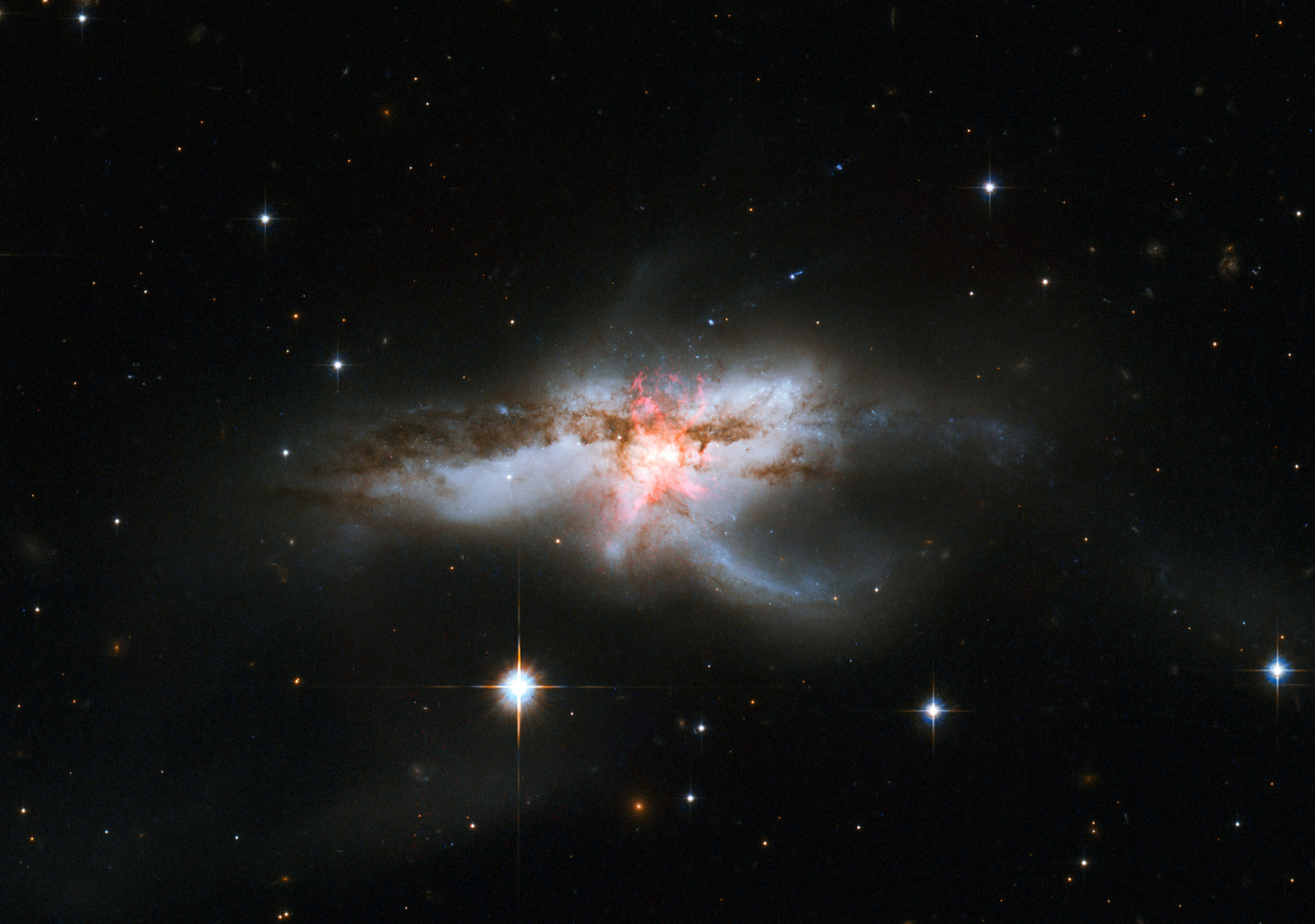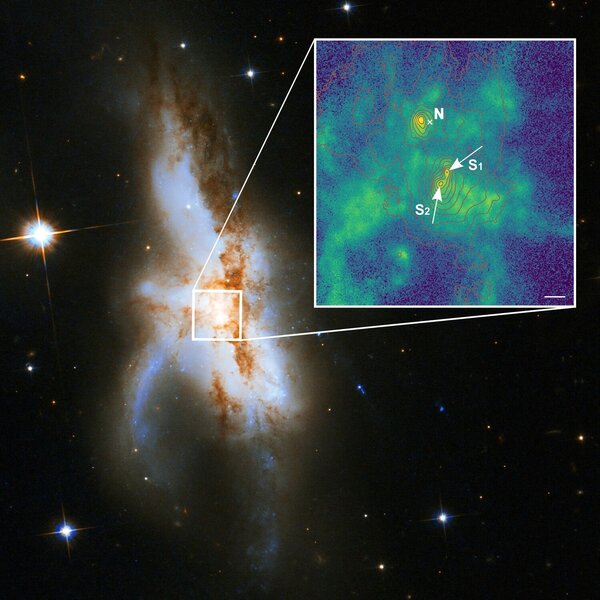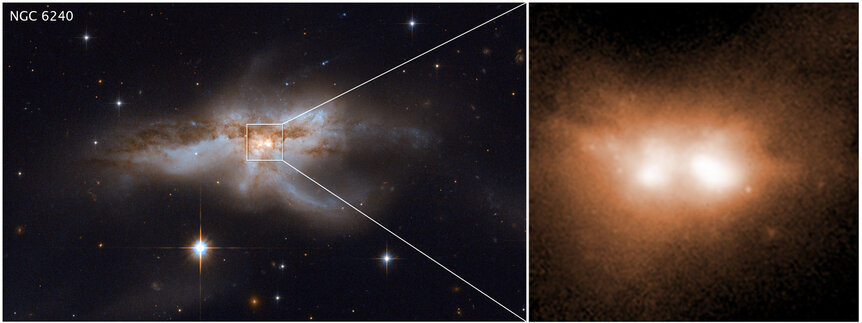Create a free profile to get unlimited access to exclusive videos, sweepstakes, and more!
A galaxy with *three* supermassive black hole hearts

We've known for some time now that at the heart of every big galaxy lies a supermassive black hole. These monsters earn their moniker: They range from millions to many billions of times the mass of the Sun. These beasts form along with their host galaxy, growing huge pretty rapidly from gas in the young galaxy.
But this one-big-black-hole-to-a-galaxy isn't always the case. Some galaxies have two supermassive black holes in their core, which is probably due to galactic mergers. Galaxies can sometimes collide and coalesce, forming one much larger galaxy. Our own Milky Way has grown to its present hefty mass this way, though we only have one black hole in our core.
And even then this isn't always the case…
NGC 6240 is very clearly a galaxy undergoing a pretty substantial collision. It's a cosmic train wreck, with long streamers of stars pulled from it, dust everywhere, and just that overall look of two galaxies in the middle of becoming one. It's been known for a while that there are two supermassive black holes in its middle, which is not too surprising given the circumstances.
What is surprising, though, is that it doesn't have two supermassive black holes in its center. It has three.
NGC 6240 is a little over 300 million light years away, which is relatively close in a cosmic sense, making it one of the more nearby examples of a galaxy collision. It's pretty well-studied, and has been observed by Hubble before, too. Various observations have shown it to have two separate nuclei separated by about 3,000 light years. Not only that, but radio and X-ray observations have indicated the black holes there are active, meaning vast amounts of material are falling into them. This stuff forms a disk around each black hole, with the matter heating up hugely due to friction, and emitting light across the electromagnetic spectrum. Two such sources are seen, so all the evidence appears to point toward there being two black holes.
New observations though, taken at very high resolution, show that NGC 6240 has been fooling us: One of those two galactic nuclei is itself two nuclei! The northern nucleus is a single galactic core, but the southern one is actually two distinct cores, separated by only about 600 light years. That's really tight, which is why this has escaped detection until now.
The observations were made using an instrument called MUSE (Multi-Unit Spectroscopic Explorer) on the European Southern Observatory’s Very Large Telescope. VLT is actually four telescopes, and MUSE is mounted on one of them. That's still quite a thing, since the telescope is a mammoth 8.2-meter mirror! So it can see faint objects very well, and get very good resolution on them too.
Even that wasn't quite enough, though. They also had to use Gaia, a space-based observatory that's measuring the positions and motions of over a billion stars, to get their data aligned as perfectly as possible.
Once they did this, they could see that the northern nucleus of NGC 6240 is one of the active supermassive black holes, and that the double southern nucleus has the other. Looking more carefully at the southern one, they found that the two cores are moving around each other, with one redshifted (currently moving away from us in the orbit) and the other blueshifted (moving toward us). Given the sizes, distance between them, and the velocity to produce the shifts, this means they both must have supermassive black holes in them, making this a triple-black-hole extravaganza.
It's not clear exactly how massive each one is, but all three are at least 90 million times the mass of the Sun (and two of them could be substantially more massive). That makes them fair-to-middlin' as far as supermassive black holes go (the one in the Milky Way is a little over 4 million solar masses, but ones tens of billions of solar masses have been found).
It's not their masses that make them important, though, it's that there are three there! This means there must have been at least one previous collision involved; perhaps two galaxies merged, then subsequently collided with a third galaxy to produce what we see now. This is thought to be pretty rare in the local Universe, so finding an example is a nice discovery.
Eventually these black holes will get close enough to each other to themselves collide. This is a pretty rare event, as it takes a long time to happen. However, having a third one there can speed the process up. Interactions between all three monsters are chaotic, with their orbits around each other changing rapidly (in a cosmic sense). As they get closer, the orbits can get stretched out so that two of them can approach pretty closely. The third (usually the lowest mass one) can then swing by, stealing orbital energy from the other two. This drops those two even closer together, so they can collide more rapidly, at the expense of ejecting the third one out of the core.
This is a difficult scenario to grasp with our puny ape brains. Objects with millions of times the Sun's mass slinging each other around like that, with two merging (and sending out powerful gravitational waves), while the third gets tossed out completely! We don't know how often this happens, but it seems clear that there are supermassive black holes out there in the Universe, plying their way through intergalactic space.
How's that for something to think about? I'm kinda glad there's so much space between galaxies. That would be a heckuva thing to run into by accident.
It's not clear just when all this will happen in the heart of NGC 6240, but I’m sure it'll be millions of years from now, if not more. That's plenty of time to figure all this out. But it makes me think we should be looking more carefully at other double nuclei galaxies, too. This may be a rare configuration, but how rare? Astronomers will want to figure this out, so that we can better understand what happens when galaxies collide, and the monsters in their middles battle it out.

















